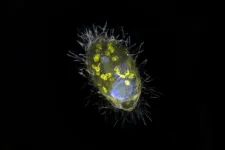(Press-News.org) New research shows 64 countries cut their fossil CO2 emissions during 2016-2019, but the rate of reduction needs to increase tenfold to meet the Paris Agreement aims to tackle climate change.
This first global stocktake by researchers at the University of East Anglia (UEA), Stanford University and the Global Carbon Project examined progress in cutting fossil CO2 emissions since the Paris Agreement was adopted in 2015. Their results show the clear need for far greater ambition ahead of the important UN climate summit in Glasgow in November (COP26).
The annual cuts of 0.16 billion tonnes of CO2 are only 10 per cent of the 1-2 billion tonnes of CO2 cuts that are needed globally every year to tackle climate change.
While emissions decreased in 64 countries, they increased in 150 countries. Globally, emissions grew by 0.21 billion tonnes of CO2 per year during 2016-2019 compared to 2011-2015.
The scientists' findings, 'Fossil CO2 emissions in the post-COVID era', are published today in Nature Climate Change.
In 2020, confinement measures to tackle the COVID-19 pandemic cut global emissions by 2.6 billion tonnes of CO2, about 7 per cent below 2019 levels. The researchers say 2020 is a 'pause button' that cannot realistically continue while the world overwhelmingly relies on fossil fuels, and confinement policies are neither a sustainable nor desirable solution to the climate crisis.
Prof Corinne Le Quéré, Royal Society Professor at UEA's School of Environmental Sciences, led the analysis. She said: "Countries' efforts to cut CO2 emissions since the Paris Agreement are starting to pay off, but actions are not large-scale enough yet and emissions are still increasing in way too many countries.
"The drop in CO2 emissions from responses to COVID-19 highlights the scale of actions and of international adherence needed to tackle climate change. Now we need large-scale actions that are good for human health and good for the planet.
"It is in everyone's best interests to build back better to speed the urgent transition to clean energy."
Annual cuts of 1-2 billion tonnes of CO2 are needed throughout the 2020s and beyond to avoid exceeding global warming within the range 1.5 °C to well below 2 °C, the ambition of the UN Paris Agreement. The world has warmed by over 1 °C since the Industrial Revolution because of emissions of greenhouse gases from human activities.
Of the 36 high-income countries, 25 saw their emissions decrease during 2016-2019 compared to 2011-2015, including the USA (-0.7 per cent), the European Union (-0.9 per cent), and the UK (-3.6 per cent). Emissions decreased even when accounting for the carbon footprint of imported goods produced in other countries.
Thirty of 99 upper-middle income countries also saw their emissions decrease during 2016-2019 compared to 2011-2015, suggesting that actions to reduce emissions are now in motion in many countries worldwide. Mexico (-1.3 per cent) is a notable example in that group, while China's emissions increased 0.4 per cent, much less than the 6.2 per cent annual growth of 2011-2015.
The growing number of climate change laws and policies appear to have played a key role in curbing the growth in emissions during 2016-2019. There are now more than 2000 climate laws and policies worldwide.
A full bounce-back in 2021 to previous CO2 emission levels appears unlikely. However, the authors say unless the COVID-19 recovery directs investments in clean energy and the green economy, emissions will likely start increasing again within a few years. The nature of the disruption in 2020, particularly affecting road transport, means incentive to expedite the large-scale deployment of electric vehicles and encourage walking and cycling in cities are timely and would also improve public health. The resilience of renewable energy throughout the crisis, falling costs, and air quality benefits, are additional incentives to support their large-scale deployment.
Investments post-COVID continue to be overwhelmingly dominated by fossil fuels in most countries, in contradiction with climate commitments, including in the United States and China. The European Union, Denmark, France, the United Kingdom, Germany and Switzerland are among the few countries that have so far implemented substantial green stimulus packages with limited investments in fossil-based activities.
Prof Rob Jackson of Stanford University co-authored the study. He said: "The growing commitments by countries to reach net zero emissions within decades strengthens the climate ambition needed at COP26 in Glasgow. Greater ambition is now backed by leaders of the three biggest emitters: China, the United States, and the European Commission."
"Commitments alone aren't enough. Countries need to align post-COVID incentives with climate targets this decade, based on sound science and credible implementation plans."
Prof Le Quéré added: "This pressing timeline is constantly underscored by the rapid unfolding of extreme climate impacts worldwide."
INFORMATION:
See the latest emissions figures comparing country by country progress with their CO2 emissions. Anthony De-Gol at UEA has created an application that enables emissions data to be shown by country:
https://enactivescience.com/gcp/
The paper, 'Fossil CO2 emissions in the post-COVID era', is published March 3, 2021 in Nature Climate Change.
SPOKANE, Wash. - The researchers' findings showed that participants who were given A low-cost, easy-to-administer intervention that uses small prizes and other incentives to reward alcohol abstinence can serve as an effective tool to reduce alcohol use among American Indian and Alaska Native communities, new research suggests.
Published today in JAMA Psychiatry, the study tested a culturally adapted version of an intervention known as contingency management in American Indian and Alaska Native adults diagnosed with alcohol dependence, a severe form of ...
During the COVID-19 pandemic in 2020, there was a 34% increase in alcohol withdrawal (AW) rates among hospitalized patients at ChristianaCare, according to a research letter published today in the Journal of the American Medical Association.
The study is believed to be the first to quantify the impact of the COVID-19 pandemic on alcohol withdrawal among hospitalized patients.
The retrospective study conducted at ChristianaCare, one of the largest health systems in the mid-Atlantic region, found that the rate of alcohol withdrawal in hospitalized patients was consistently higher in 2020 compared to both 2019 and the average of 2019 and 2018.
"Our findings are relevant nationally and serve as a clarion call to alert ...
What The Study Did: Whether alcohol withdrawal rates among hospitalized patients with alcohol use disorder increased during the COVID-19 pandemic was examined in this study.
Authors: Ram A. Sharma M.D., of Christiana Care in ,Newark, Delaware, is the corresponding author.
To access the embargoed study: Visit our For The Media website at this link https://media.jamanetwork.com/
(doi:10.1001/jamanetworkopen.2021.0422)
Editor's Note: The article includes conflict of interest and funding/support disclosures. Please see the article for additional information, including other authors, author ...
What The Study Did: Researchers in this randomized clinical trial examined the effectiveness of incentives offered for laboratory-confirmed abstinence from alcohol among American Indian and Alaska Native adults diagnosed with alcohol dependence.
Authors: Michael G. McDonell, Ph.D., of Washington State University in Spokane, is the corresponding author.
To access the embargoed study: Visit our For The Media website at this link https://media.jamanetwork.com/
(10.1001/jamapsychiatry.2020.4768)
Editor's Note: The article includes conflict of interest and funding and support disclosures. Please see the article for additional ...
What The Study Did: This study combined the results of 27 studies with 10,000 participants to investigate the association between cardiovascular risk factors such as diabetes and high blood pressure and cognitive impairment in people with schizophrenia.
Authors: Christoph U. Correll, M.D., of the Zucker Hillside Hospital in Glen Oaks, New York, is the corresponding author.
To access the embargoed study: Visit our For The Media website at this link https://media.jamanetwork.com/
(10.1001/jamapsychiatry.2021.0015)
Editor's Note: The article includes conflict of interest ...
Water levels in the world's ponds, lakes and human-managed reservoirs rise and fall from season to season. But until now, it has been difficult to parse out exactly how much of that variation is caused by humans as opposed to natural cycles.
Analysis of new satellite data published March 3 in Nature shows fully 57 percent of the seasonal variability in Earth's surface water storage now occurs in dammed reservoirs and other water bodies managed by people.
"Humans have a dominant effect on Earth's water cycle," said lead author Sarah Cooley, a postdoctoral scholar ...
Researchers from Bremen, together with their colleagues from the Max Planck Genome Center in Cologne and the aquatic research institute Eawag from Switzerland, have discovered a unique bacterium that lives inside a unicellular eukaryote and provides it with energy. Unlike mitochondria, this so-called endosymbiont derives energy from the respiration of nitrate, not oxygen. "Such partnership is completely new," says Jana Milucka, the senior author on the Nature. "A symbiosis that is based on respiration and transfer of energy is to this date unprecedented".
In general, among eukaryotes, symbioses ...
An international research group led by the University of Basel has developed a promising strategy for therapeutic cancer vaccines. Using two different viruses as vehicles, they administered specific tumor components in experiments on mice with cancer in order to stimulate their immune system to attack the tumor. The approach is now being tested in clinical studies.
Making use of the immune system as an ally in the fight against cancer forms the basis of a wide range of modern cancer therapies. One of these is therapeutic cancer vaccination: following diagnosis, specialists set about determining which components of the tumor could function as an identifying feature for the immune system. The patient is then administered ...
The universe was created by a giant bang; the Big Bang 13.8 billion years ago, and then it started to expand. The expansion is ongoing: it is still being stretched out in all directions like a balloon being inflated.
Physicists agree on this much, but something is wrong. Measuring the expansion rate of the universe in different ways leads to different results.
So, is something wrong with the methods of measurement? Or is something going on in the universe that physicists have not yet discovered and therefore have not taken into account?
It could very well be the latter, according to several physicists, i.a. Martin S. Sloth, Professor of Cosmology at University of Southern Denmark (SDU).
In a new scientific article, he and his SDU ...
A new software tool allows researchers to quickly query datasets generated from single-cell sequencing. Users can identify which cell types any combination of genes are active in. Published in Nature Methods on 1st March, the open-access 'scfind' software enables swift analysis of multiple datasets containing millions of cells by a wide range of users, on a standard computer.
Processing times for such datasets are just a few seconds, saving time and computing costs. The tool, developed by researchers at the Wellcome Sanger Institute, can be used much like a search engine, as users can input free text as well as gene names.
Techniques to sequence the genetic material from an individual cell have advanced ...


